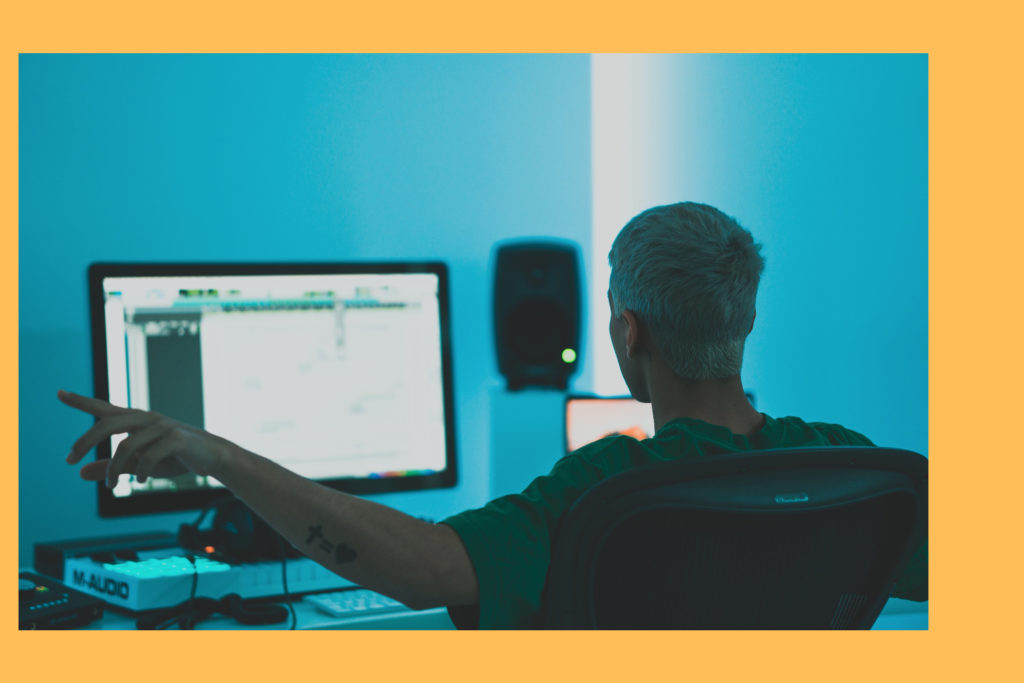+ Create and arrange original, instrumental hip-hop music from sampling pioneer RJD2 in his Soundfly course, RJD2: From Samples to Songs.
We all have different workflows in our digital audio workstations (DAWs), and it’s not uncommon for them to change over time! Unfortunately, some producers never focus on their workflow as a way to improve their productions.
Why is your workflow important?
While some artists feel like workflow restrictions impact their creativity, others thrive. Building in processes to how you create songs can lead to even better results.
Imagine you recorded a great guitar chord progression. The melody and rhythm are cool and you can’t wait to build a track around it. But as soon as you load up a VST piano, you realize that your guitar loop is out of tune! You forgot to tune your guitar before starting.
Having a production workflow that loads a tuning plugin to your guitar tracks could help. It could remind you to check your tuning before you even start. Tuning the guitar in Melodyne will take much longer than getting it right to start with!
An efficient creative environment can help you finish better songs.
Creating and Using DAW Templates
For starters, your production should start with a template. A template lets you make setting up a session a breeze. It includes pre-made audio and MIDI channels to get your project going. They’re color coded and bussed into your most used plugins.
Save these production templates to help you start creating quickly.

For example, I have a kick drum channel already created in my template. It’s color coded and placed at the bottom of my session where I like to mix my drums. It has a pre-made EQ on the channel to mellow out some bass frequencies. There’s also a compressor pre-loaded with some shaping settings I use often.
Obviously, every song and mix are different. But when I’m always reaching for similar tools in my drum production, I use this template as a starting point.
Also in my template are a few instances of Serum and Sylenth. These are my go-to soft synths for songwriting. They start pre-loaded on piano patches to start writing chords as soon as my session loads.
Finally, I have audio tracks armed for scratch vocals and guitars. These are both commonly in my productions. Create a few templates and update them whenever you find something new that could help! As your productions evolve, you’ll learn what plugins and busses you use most often.
+ Read more on Flypaper: “How to Streamline Your Songwriting and Production Processes.”
Color Coding Tracks
Color coding your tracks is also a great way to speed up your process. Dumping samples, loops, and recording audio can fill up your project quickly. Use color coding to separate different types of instruments and tracks.
It’s easy to lose track of a clap sample in a sea of synths. With color coding, you can rearrange your project to keep certain elements together. For example, many pop-centric producers keep vocals at the top of their sessions. Melodic instruments come next and drums are usually at the bottom.
There are no right or wrong ways to color code your session. But there are plenty of common conventions that many producers follow!

Name Your Channels
Get into the habit of naming your channels. For starters, the way you name channels makes recording easier. Easily scan file names and know where your reverbs and routing channels are. As you export stems for a mixing engineer, your naming convention can also make it easier for them to get started.
Many producers will name each track with the type of file it is followed by more information. For example, a drum track may be named “DRUMS_Wide Clap.” Guitars could be called “GTR_Rhythm Left.”
It doesn’t matter what you use to name your tracks as long as it’s consistent and easy to understand.
Use Labels and Markers
Use tags and labels to describe your arrangement. DAWs like Logic and Pro Tools let you create markers for different song sections. Verses, choruses, and bridge sections can all get labeled to make jumping around a breeze.
If you send your session to other producers to collaborate, they’ll be able to see your song sections too. Some common markers and labels are:
- Intro
- Verse
- Pre-chorus
- Buildup
- Drop
- Chorus
- Break
- Bridge
- Outro
- Instrumental
Organize Your Sounds and Samples
Organizing your sounds is very important. Many of us have gigabytes of samples, loops, and one-shots. Keeping these all in your downloads folder slows you down when you’re looking for something to finish your song.
Most DAWs give you organization tools to pre-load sample libraries and keep them sorted. The same thing goes with your synth and patch libraries. Keep folders named so that you always know where to find the sounds you need.
It’s not sexy to organize your sounds. But if you’ve got a quiet day or two it can be a big investment in your studio workflow.

Save Different Versions
Once you’re ready to start bouncing out versions of your songs, how you name them is important! Don’t hit the keyboard and call your demo “asdlfkjasdfl.” Spend time to name your project and come up with consistent naming conventions.
If you’re working with clients, this will help you know what files they’re referencing when they send notes. Personally, I use a format of “songname-version-date.” That could look like “here-we-go-v3-march-10.”
Stay Organized With Feedback
Keep your finished projects separate from your works in progress. After you’re ready to export a file and send it to clients, you can use a platform like Notetracks to share feedback. Invite collaborators to share creative ideas and keep your versions all in one place.
When you sign off on the final mix, you can move the project to a finalized folder on your computer. Notetracks lets you manage versions and keep you on track to a final mix.
Every producer’s workflow is different. It can take months or years to find one that fits into your creative style. But implementing some basic organizational tips can speed up your projects! Use consistent naming and take time to make reusable templates in your workflow.
Ask other producers how they keep their project workflow sane! What tips do you have for working as a producer?
Don’t stop here!
Continue learning with hundreds of lessons on songwriting, mixing, recording and production, composing, beat making, and more on Soundfly, with artist-led courses by Kimbra, Jlin, Kiefer, RJD2, Ryan Lott, and of course, Com Truise: Mid-Fi Synthwave Slow-Motion Funk.
—
Kam Lal is the founder and CEO of Notetracks. He is based in Montreal and has a passion for music and tech.





